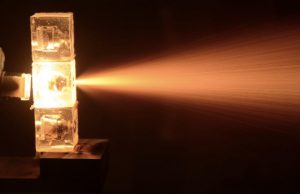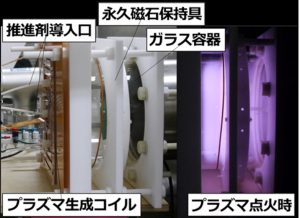Research and application of Advanced Space Propulsion Machine

A ground test of an ion thruster mounted on PROCYON-FM
Research and application of Advanced Space Propulsion Machine
Associate Professor Hiroyuki Koizumi (Department of Advanced Energy Engineering, Graduate School of Frontier Sciences)
We are conducting research and projects on space propulsion engineering and plasma engineering in our laboratory. The goal is to promote space propulsion research leading the future space scene, and now we are focusing on micro propulsion for small satellites and new large electric propulsion machines. In addition, we actively work on actual utilization projects as a place of actual use of research results. Basic research and practical use are like the two wheels of a car, and I believe that it is important for engineering to connect them closely. Especially, small propulsion system has low hurdle for practical use of space, and it is a big appeal that there are many project opportunities. Current research and projects are as follows.
Small low power ion thruster
We are studying a compact low-power ion thruster for small satellite of 50 kg class. Small satellites of the same class are being put into practical use as a meeting point of mission abilities and development simplicity. So far, I realized a compact ion thruster with 1 W microwave power, demonstrated the operation of the ion thruster in the 100-kg or less satellite (Unit 4) and the demonstration of the propulsion system in the micro space explorer PROCYON I have done it. Both are the first demonstrations in the world. Currently, we are conducting research on reliability and performance of the small ion thruster and research on ion thrusters using water as a propellant. We are promoting high performance through experiments in this laboratory and numerical calculations at Yokohama National University and Tokyo Industrial College of Technology.
Water resist jet thruster
Can be mounted on CubeSat has been conducting research on water resist jet as a study of ultra-small propulsion. CubeSat but was ultra-small satellite of the original 10 cm cubic, currently in the 10 cm cube one unit: as 1U, 3U cube, CubeSat use of size, such as 6U cube has been developed. In this study, compared with the resist jet that have been studied in the past, but its main purpose is to realize the ultra-compact propulsion system that specializes in safety and handling properties for the CubeSat. This water resist jet, the University of Tokyo and JAXA is the propulsion system of the mounting scheduled to deep space exploration for the 6U CubeSat EQUULEUS proposed jointly: We are developing as AQUARIUS (AQUA ResIstojet prpUlsion System).
Small solid thruster

Laser ignition Small solid thruster during burning (1 g of gunpowder)
We are conducting research on compact solid thrusters as a micro propulsion system that can be mounted on cube sat and can deliver large thrust for reentry. A point that uses laser ignition in vacuum from securing of safety and reliability / immediacy of ignition is a point that burns with small solid propellant (gunpowder) as small as about 1 g. We are conducting research from practical to basic because there are many unknown points in vacuum atmosphere ignition and subsequent combustion process in small resin case. As a practical matter, it is far simpler than propulsion systems using gas and liquid, and it is characterized by its high affinity for spacecraft systems. We are carrying out research and development jointly with the Tokyo Metropolitan Industrial Technology College and it was launched in 2009 after the demonstration thruster was mounted on the cube Sat of Tokyo Metropolitan Industrial Technology College (then Aircraft College of Technology).
Electromagnetic induction accelerating propulsion machine

State of high-frequency plasma generation for electromagnetic induction accelerator / propeller
We are pursuing research on fully electrodeless high power electric propulsion featuring high-frequency plasma generation + electromagnetic induction acceleration aiming for large-scale transportation age through future electric propulsion. In the past, studies using electromagnetic induction acceleration have TWTA (Traveling Wave Tube Accelerator) and PIT (Pulsed Inductive Thruster, still continuing), and in recent years there is research using helicon plasma (Princeton University, College of Engineering). In this research, we characterize low aspect ratio cusp magnetic field in plasma generation and features that do not depend on external magnetic field in plasma acceleration. As research, it is in the basic stage, and we are studying optimization from demonstration of acceleration.
Laboratory homepage
http://www.al.t.u-tokyo.ac.jp/koizumi/html/htdocs/

